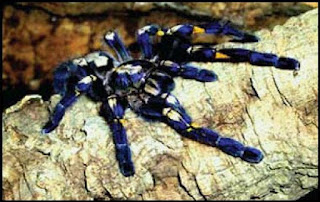Believe it or not, these eight legged creatures comprise the
largest order of animals in the animal kingdom. As with other micro fauna, the Indian
subcontinent is rich with spider diversity too. According to an updated check list in 2012 India has1685 spider species from
438 genera and 60 families . Among this, 91 species are Mygalomorphs or
spiders with their fangs pointed down without crossing each other, as in
other group of spiders. The remaining 1595species
belong to Araneomorphs, or spiders with fangs which are opposite in direction,
crossing over to each other.
These spiders are found to be semi-social which makes them live
some time in groups or alone. These shy creatures tend to live in hiding and
are found along the coastal savannah, tropical lowland rain forests and montane
forests. They have been reported from altitudes up to 2000 m above mean sea
level.
According to research reports, out of the total spider
species found in India, 70 are exclusively from Karakorum area, or in other words,
endemic to Karakorum area.
Critically Endangered
Spiders of India
According to International Union for Conservation of Nature
(IUCN) the international agency which monitors the conservation status of
organisms,If the population decline is severe among a species which
wipes away almost 90 percent of the population in a decade, that species can be
considered as critically endangered.
IUCN also suggest that if the extent of occurrence of the organism shrinks to 100 km2 area, or to a single location, it can be listed as critically endangered, indicating that it is closer to a possible extinction or a state where it no more exist in the face of the mother earth. If only less than 250 mature members of the species are known to exist, it also indicate that a species is critically endangered.
IUCN also suggest that if the extent of occurrence of the organism shrinks to 100 km2 area, or to a single location, it can be listed as critically endangered, indicating that it is closer to a possible extinction or a state where it no more exist in the face of the mother earth. If only less than 250 mature members of the species are known to exist, it also indicate that a species is critically endangered.
The Rameswaram
Ornamental Spider (Poecilotheria hanumavilasumica)
Also known as the Rameswaram Parachute Spider, this
beautiful organism is facing the risk of a possible extinction from the face of
earth. This special spider has been so far found only from India, with the last
record being from 2004.
 |
| The Rameswaram Ornamental Spider |
These spiders are dangerous with their ability to deliver
quick poisonous bites. But their bits are not fatal in nature. However, they
are finding their population falling down with their typical habitats being
altered and degraded due to human intervention.
Present conservation
status
According to IUCN, Rameswaram Parachute Spiders are restricted
to a Rameswaram Island and the associated mainland close to the island, limiting
its presence to a 100 km² area. However, based on the reports of occurrence, the
actual area of occurrence of these rare species of spiders can be less than 6 km² area. IUCN documents claim that they are found on tamarind, casuarina
and mixed dry deciduous tree and palm plantations here.
Apart from the island,
the species has been recorded from less than 15 severely fragmented locations
also.
The alteration of habitat is the major threat to these
spiders as their distribution is restricted. For instance, when the tamarind
plantation sprawling to 5 hectares were recently grazed down by government authorities
to build up government quarters, it killed all the 70 individuals found in the plantation.
The flood o tourists and the associated construction activities are again
sweeping away the remaining population of this rare spider.
Due to the loss of natural vegetation, continuing decline in
area and absence of enough mature individuals may soon make this rare creature
to vanish from the face of earth. Unfortunately, the legal machinery in India
is yet o make any move to save this spider.
The Gooty Tarantula (Poecilotheria
metallica)
Also known as Peacock Parachute Spider, this magnificent
creature is also facing risk of extinction in Indian subcontinent to which it
is endemic. With a visually appealing steel blue color and patches of intense
orange-yellow, black and white, it is also a victim of international pet
trading rackets which smuggle them beyond borders to sell.
Reported from Gooty (Ooty/Udagamandalam) and from forests between
Nandyal and Giddalur in the state of Andhra Pradesh in South India, it is also believed
to have an area of occurrence of less than 100 km².
While habitat loss and degradation are the major threats to
this spider which is known to live in deciduous forests, international pet
trade rackets are the second major threat to these small beautiful creatures. IUCN
has issued a warning that at the present rate, the species may disappear from
earth in the near future.


No comments:
Post a Comment
Please feel free to have your say on our stories. Comments will be moderated. anonymous Comments will not be approved. No links in the comment body unless meant for sharing a very relevant info.